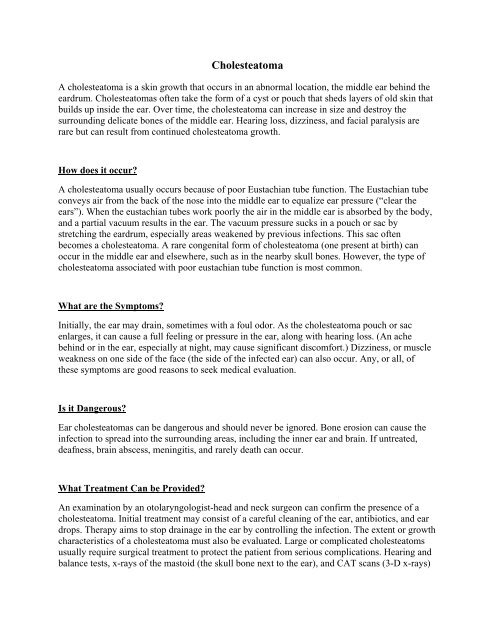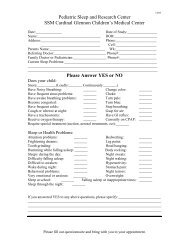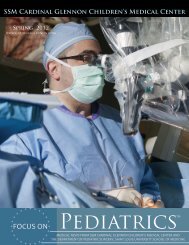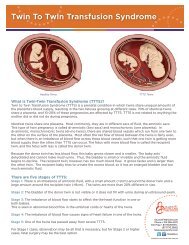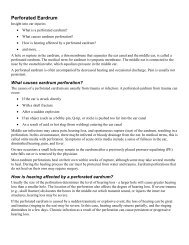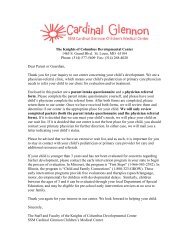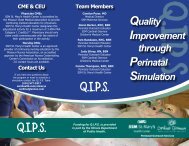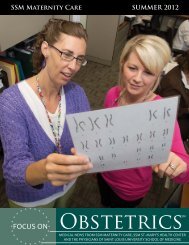Cholesteatoma
Cholesteatoma
Cholesteatoma
- No tags were found...
You also want an ePaper? Increase the reach of your titles
YUMPU automatically turns print PDFs into web optimized ePapers that Google loves.
<strong>Cholesteatoma</strong>A cholesteatoma is a skin growth that occurs in an abnormal location, the middle ear behind theeardrum. <strong>Cholesteatoma</strong>s often take the form of a cyst or pouch that sheds layers of old skin thatbuilds up inside the ear. Over time, the cholesteatoma can increase in size and destroy thesurrounding delicate bones of the middle ear. Hearing loss, dizziness, and facial paralysis arerare but can result from continued cholesteatoma growth.How does it occur?A cholesteatoma usually occurs because of poor Eustachian tube function. The Eustachian tubeconveys air from the back of the nose into the middle ear to equalize ear pressure (“clear theears”). When the eustachian tubes work poorly the air in the middle ear is absorbed by the body,and a partial vacuum results in the ear. The vacuum pressure sucks in a pouch or sac bystretching the eardrum, especially areas weakened by previous infections. This sac oftenbecomes a cholesteatoma. A rare congenital form of cholesteatoma (one present at birth) canoccur in the middle ear and elsewhere, such as in the nearby skull bones. However, the type ofcholesteatoma associated with poor eustachian tube function is most common.What are the Symptoms?Initially, the ear may drain, sometimes with a foul odor. As the cholesteatoma pouch or sacenlarges, it can cause a full feeling or pressure in the ear, along with hearing loss. (An achebehind or in the ear, especially at night, may cause significant discomfort.) Dizziness, or muscleweakness on one side of the face (the side of the infected ear) can also occur. Any, or all, ofthese symptoms are good reasons to seek medical evaluation.Is it Dangerous?Ear cholesteatomas can be dangerous and should never be ignored. Bone erosion can cause theinfection to spread into the surrounding areas, including the inner ear and brain. If untreated,deafness, brain abscess, meningitis, and rarely death can occur.What Treatment Can be Provided?An examination by an otolaryngologist-head and neck surgeon can confirm the presence of acholesteatoma. Initial treatment may consist of a careful cleaning of the ear, antibiotics, and eardrops. Therapy aims to stop drainage in the ear by controlling the infection. The extent or growthcharacteristics of a cholesteatoma must also be evaluated. Large or complicated cholesteatomsusually require surgical treatment to protect the patient from serious complications. Hearing andbalance tests, x-rays of the mastoid (the skull bone next to the ear), and CAT scans (3-D x-rays)
of the mastoid may be necessary. These tests are performed to determine the hearing levelremaining in the ear and the extent of destruction the cholesteatoma has caused.Surgery is performed under general anesthesia in most cases. The primary purpose of the surgeryis to remove the cholesteatoms and infection and achieve an infection-free, dry ear. Hearingpreservation or restoration is the second goal of surgery. In cases of severe ear destruction,reconstruction may not be possible. Complete removal of a cholesteatoma is not always possiblein one operation; and therefore, a second operative may be performed six to twelve months later.The second operation may attempt to restore hearing and, at the same time, inspect the middleear space and mastoid for residual cholesteatoma.Follow-up office visits after surgical treatment is necessary and important, becausecholesteatoma sometimes recurs. In cases where an open mastoidectomy cavity has been created,office visits every few months are needed in order to clean out the mastoid cavity and preventnew infections. In some patients, there must be lifelong periodic ear examinations.Summary<strong>Cholesteatoma</strong> is a serious but treatable ear condition which can only be diagnosed by medicalexamination. Persisting earache, ear drainage, ear pressure, hearing loss, dizziness, or facialmuscle weakness signals the need for evaluation by an otolaryngologist-head and neck surgeon.


